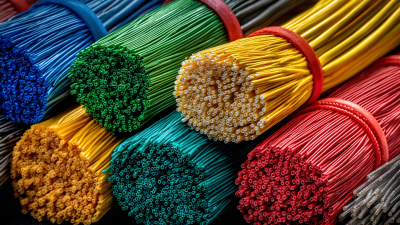
-
Home
-
Products
-
PVC Cable Material
-
Low Smoke Zero Halogen Cable Material
-
Cable material
-
Optical fiber cable
-
-
About Us
-
VR
-
News
-
Blog
-
Contact Us
Leave Your Message

In the fast-evolving world of construction and telecommunications, the choice of materials can significantly impact project efficiency and durability. One such innovative solution that has gained traction is the Pp Cable Filling Rope. According to a recent industry report by MarketsandMarkets, the global demand for high-quality filling materials in cable production is projected to grow at a CAGR of 5.2% from 2021 to 2026, highlighting the critical role of advanced materials like Pp Cable Filling Rope. This versatile product offers unique advantages, including enhanced flexibility, moisture resistance, and superior tensile strength, making it an ideal choice for a variety of projects. As professionals seek to optimize performance and reduce costs, understanding the benefits of Pp Cable Filling Rope becomes essential for ensuring project success and longevity.

PP Cable Filling Rope stands out in the world of project materials due to its unique composition and properties. Made from polypropylene, a synthetic polymer, this rope is both lightweight and highly durable, making it an excellent choice for various applications. According to industry reports, the tensile strength of PP ropes can exceed 600 MPa, which indicates their capability to withstand significant loads without compromising integrity. This makes PP Cable Filling Rope not just practical, but a reliable option for demanding environments.
Another notable aspect of PP Cable Filling Rope is its resistance to moisture and chemicals, which significantly enhances its lifespan. Research indicates that the use of such ropes in cable management can reduce the risk of corrosion and damage, especially when exposed to harsh weather conditions. This resilience is critical in the telecommunications and electrical sectors, where protecting cables from environmental factors is paramount. Moreover, with its low density, PP rope contributes to lighter overall project designs, which can lead to substantial cost savings during transportation and installation.
When it comes to selecting materials for your projects, few options match the versatility and reliability of PP cable filling rope. Not only does it enhance the durability of your installations, but it also offers a range of benefits that can significantly improve project outcomes. According to industry reports, PP cable filling ropes demonstrate exceptional resistance to moisture and UV exposure, making them ideal for both indoor and outdoor applications. This resilience ensures longevity, reducing the frequency of replacements and maintenance costs.
Incorporating PP cable filling rope also contributes to effective cable management. Its lightweight yet strong characteristics simplify the installation process, allowing for quicker and more efficient project execution. Industry studies indicate that using high-quality filling ropes can increase installation speed by up to 30%. This increased efficiency translates into better productivity and resource allocation, proving essential in today’s fast-paced work environments.
Tip 1: Ensure you're using the correct diameter of PP cable filling rope for your specific project needs to maximize strength and reliability. Tip 2: Always check for industry certifications to guarantee the quality of the materials you are using, as this can significantly influence the overall performance of your installations.
When selecting the right PP cable filling rope for your projects, it's essential to consider several key factors to ensure optimal performance. First, evaluate the specific requirements of your project—whether you're focusing on strength, flexibility, or environmental resistance. PP cable filling ropes come in various thicknesses and tensile strengths, so understanding the demands of your application will guide you in choosing the most suitable option. For instance, if you're working in a high-stress environment, opting for a thicker rope with a higher tensile strength may be necessary.
Additionally, consider the rope's resistance to UV light and moisture. Projects that are exposed to outdoor elements will require a filling rope that can withstand such conditions without degrading over time. It's also important to take into account the ease of handling and installation. A lighter, more flexible rope can save time during setup while still providing the durability needed for long-term use. By keeping these considerations in mind, you can make an informed decision that aligns with both your project requirements and operational needs.
| Benefit | Description | Use Case | Key Feature |
|---|---|---|---|
| Lightweight | PP rope is significantly lighter than other types of rope, making it easier to handle. | Ideal for overhead installations. | Weighs less than traditional filling ropes. |
| Durability | Resistant to wear and tear, perfect for long-term use. | Used in harsh weather conditions. | High tensile strength. |
| Cost-effective | Provides excellent performance at a lower cost compared to alternatives. | Great for large-scale projects on a budget. | Affordably priced per meter. |
| Chemical Resistance | Can withstand various chemicals without degrading. | Suitable for industrial applications. | Resistant to oils and solvents. |
| Versatility | Can be used in a variety of applications ranging from telecommunications to construction. | Perfect for multi-purpose projects. | Easily adaptable to different setups. |
When it comes to optimizing your projects, PP cable filling rope is an invaluable asset that can enhance both performance and efficiency. To effectively utilize this versatile material, it's crucial to understand its unique properties and how they can be applied across various contexts. First, consider the tensile strength of PP cable filling rope, which makes it ideal for heavy-duty tasks. It can be used for securing cables, reinforcing structures, or even creating durable connections in outdoor installations where exposure to the elements is a factor.
Moreover, proper application techniques can maximize the benefits of PP cable filling rope. When deploying this rope, be mindful of the environment; for instance, in marine settings, ensure that the rope is adequately treated against saltwater exposure to prolong its life. Additionally, always adhere to the recommended load capacities to avoid any performance issues. Using appropriate knots and securing methods can also enhance the rope's effectiveness, ensuring that your projects not only meet but exceed expectations. By integrating these tips, you can streamline your processes and achieve remarkable results with PP cable filling rope.
When working with PP cable filling rope, safety should be your top priority. According to a recent industry report by the International Association of Safety Professionals, approximately 30% of workplace injuries in construction are associated with improper handling of cable and rope materials. Therefore, understanding the correct methods for utilizing PP cable filling rope is essential for maintaining a safe work environment. Always inspect the rope for wear and tear before use, ensuring it meets the required safety standards set by organizations such as the Occupational Safety and Health Administration (OSHA).
Tip: When storing PP cable filling rope, keep it in a cool, dry place to prevent degradation. Prolonged exposure to moisture can lead to mildew, which not only affects the rope's integrity but can also pose a slipping hazard.
Moreover, ensure that you are wearing the appropriate personal protective equipment (PPE) when handling this type of rope. Industry guidelines recommend gloves and safety glasses to protect against potential injuries from frayed fibers or sudden snaps. Understanding the load limits of the rope and not exceeding those limits is crucial, as per the recommendations in the American National Standards Institute (ANSI) guidelines.
Tip: Always use a double-check knot when securing loads with PP rope. This technique enhances security, reducing the likelihood of unintended release during operation.





